Hey Reader,
I know, it’s been awhile. But I’ve got some interesting posts planned for the future, so stay involved and updated.
But let’s get right into it. We’ve both got things to do, places to be.
Today’s topic: THE BIG FIVE
Not to be confused with the sporting goods chain, the Big Five is known also as the Five Factor Model (FFM). It’s a taxonomic model of generalized abstracted traits with universal applicability. These traits—Openness, Conscientiousness, Extraversion, Agreeableness, Neuroticism (OCEAN)—can be used to describe any person, to define behavior to understand the generalized direction of a given person or group’s actions. Within reason, that is.
As copywriters we can use this system to tailor our copy to appeal specifically to whatever niche customer group is most likely buying the product of our clients. Sure, a large part of our job is keyword research and SEO. But if the copy itself doesn’t appeal to the customer most likely to click on the ad in the top five pages of a given Google search, then the overall purpose of the copy, higher CTR and conversion, isn’t fulfilled, making that important keyword research and SEO info you probably spent money to obtain worthless in the eyes of the client.
HERE is an article written by Jacob B. Hirsch et al. that proves a correlation exists between tailored marketing to the FFM traits and positive consumer response. This picture shows the correlation he found when tailoring an ad to specific traits (such as, “for extraversion: ‘With XPhone, you’ll always be where the excitement is’; for neuroticism: ‘Stay safe and secure with the XPhone'”):
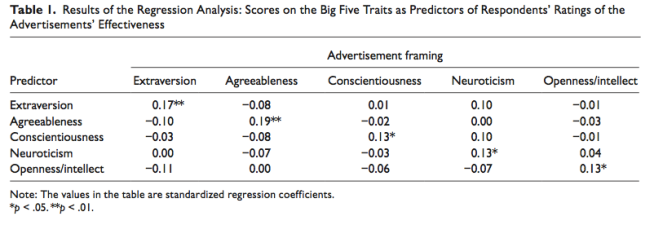
I think starting copywriters struggle to find a steady process by which to write their copy. The keyword research and SEO is relatively easy to learn as there are tens of thousands of articles each describing every step you need to take to parse out the golden words. It’s from there, though, that the great copywriters separate from the chaff. Your creativity will shine as your ability to tailor copy to specific personalities increases.
The FFM gives you a process by which to activate your creativity within psychological research and personality structure.
So let’s get started:
To get a good understanding of the history of the FFM, as well as a history of taxonomic trait models, all the big names involved and their respective experiments that eventually proved the presence of these abstract traits, you can read John M Digman’s paper on Personality Structure here.
But just to summarize it:
HISTORY
The story starts in 1932 with a conclusive statement at the end of an early academic journal by William McDougall. He thought perhaps to some benefit the study of personality might yield five factors, “namely, intellect, character, temperament, disposition, and temper”.
After this statement there came a flood of studies attempting to systematize personality through language. As Digman points out, however, these probably weren’t directly influenced by McDougall’s statement, which could be seen as a primordial ordinance of where psychological organization of personality was to head.
The actual originary force was most likely, Digman says, to be the work of two German psychologists Klages and Baumgarten, the former suggesting a study of language could define a superordinate structure of personality while the latter carried out the study utilizing common German terms about personality.
This study caught the eye of Allport and Odbert, who in 1936 began their own study of the connection between language and personality. This study then influenced the work of Cattell throughout the ’40s.
Cattell, using the term “factor” with a more recent definition than McDougall, found his 16-factor system using factor analysis, a statistical technique used to find patterns within a set of defined variables, in order to discover any factors that could explain any found patterns.
From Cattell on we see a series of psychologists using this technique in order to critique and further define Cattell’s system. Psychologists such as Banks, Fiske, Eysenck, Tupes & Christal, Borgatta and more, all were able to find a certain number of factors through the analysis of language that seemed to cluster and explain patterns of generally defined descriptions of people. Eventually the disparate examiners were able to agree upon finding five factors in their linguisitc analyses.
Further studies of questionnaires, whether self-report or peer-report, also found approximately five factors. The disagreements came with the naming of these factors and how exactly they were to be defined. Here you can see the different examiners and the names given to this trait taxonomy.

As you can see, though, the overlap among even the names is definitive. The different names could even give you a better idea of what behaviors and descriptors might fall under this or that trait.


DESCRIPTIONS OF EACH FACTOR
Here’s a picture from McCrae and John’s paper (HERE) on the FFM and its applications. It shows the different but overlapping adjectives from questionnaires as well as lexical studies that fall under each trait.

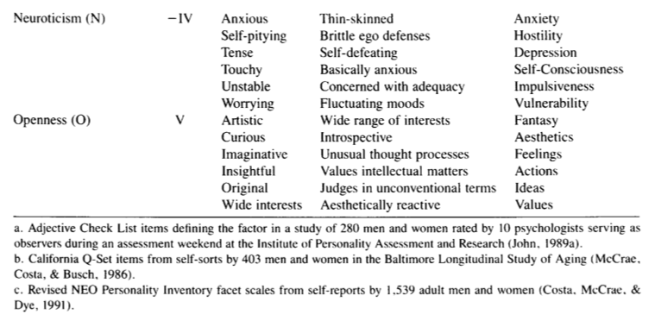
To quote from H. vazifehdoost et al.’s 2012 paper, “The Role of Psychological Traits in Market Mavenism Using Big Five Model”:
Factor I – “OPENNESS TO EXPERIENCE: (inventive/curious vs. consistent/cautious) Appreciation for art, emotion, adventure, unusual ideas, curiosity, and variety of experience. Openness reflects the degree of intellectual curiosity, creativity and a preference for novelty and variety. Some disagreement remains about how to interpret the openness factor, which is sometimes called ‘intellect’ rather than openness to experience.”
Factor II – “CONSCIENTIOUSNESS: (efficient/organized vs. easy-going careless) A tendency to show self-discipline, act dutifully, and aim for achievement; planned rather than spontaneous behavior; organized, and dependable.”
Factor III – “EXTRAVERSION: (outgoing/energetic vs. solitary/reserved) Energy, positive emotions, assertiveness, sociability and the tendency to seek stimulation in the company of others, and talkativeness.”
Factor IV – “AGREEABLENESS: (friendly/compassionate vs. cold/unkind) A tendency to be compassionate and cooperative rather than suspicious and antagonistic towards others.”
Factor V – “NEUROTICISM: (sensitive/nervous vs. secure/confident) The tendency to experience unpleasant emotions easily, such as anger, anxiety, depression, or vulnerability. Neuroticism also refers to the degree of emotional stability and impulse control, and is sometimes referred by its low pole—’emotional stability’.”
Note at the beginning of these definitions the two poles given for each trait—e.g. sensitive vs. secure; or friendly vs. cold; or inventive vs. consistent). When researching where the customers to which you to hope to appeal fall within the FFM, it’s important to keep in mind these poles. The traits themselves are abstracted and therefore don’t explain the particulars of the reasons behind a given behavior. As McCrae says, “A moderate score in Extraversion, for example, might be obtained by an individual who was energetic but aloof, or lethargic but friendly, or average on both energy level and sociability.
The traits are at a fourth level of abstraction; the first is direct responses, the second is developed habits, the third is chacteristics—the fourth is the traits of the FFM.
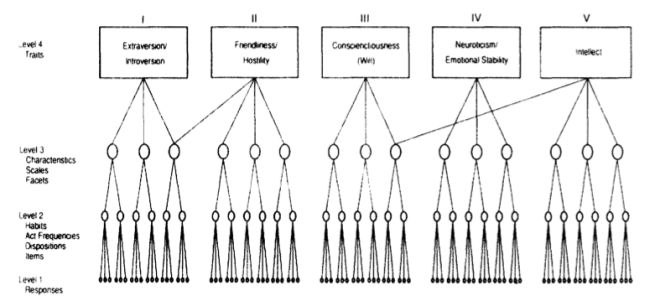
This abstraction can lead to different interpretations of what actions the factors might lead to, as well as different interpretations of what factor might correlate with this or that action or description.
DIFFERENCE OF INTERPRETATION
If you’ve got a given product you’re meant to advertise, and this product is purposed to appease some given insecurity or problem, then it’s by this insecurity or problem that you could decipher which type of personality the typical customer for this product would fall under.
(Of course more generalized products, with a larger audience, would require conversations with the client as to which direction to head; but for products directed towards a specific audience this is how the FFM could aid in formulating a helpful direction to your copy.)
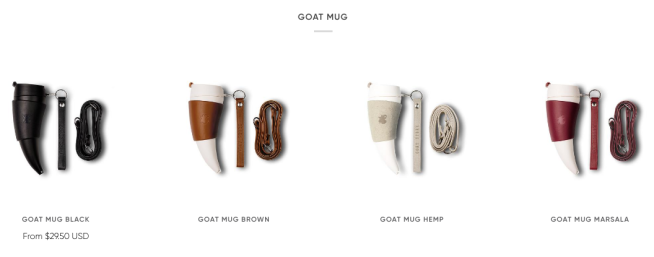
For example, the Goat Mug appeals primarily to an aesthetic need while also fulfilling a practical purpose—a reusable mug that you don’t always have to carry in your hands with a greater aesthetic appeal than a thermos.
The market for this would probably fall under the Openness to Experience. The campaign would focus on appealing to the customer’s need to experience coffee in a different, new, innovative way.
And would you look at that:
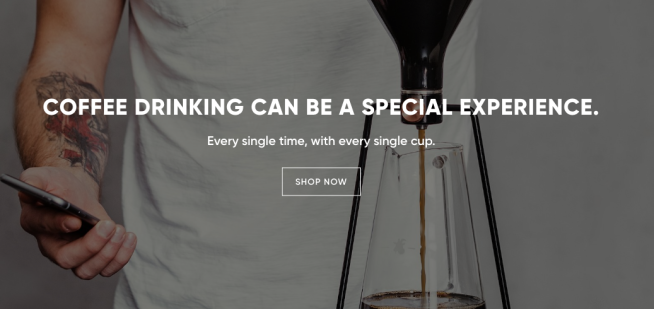
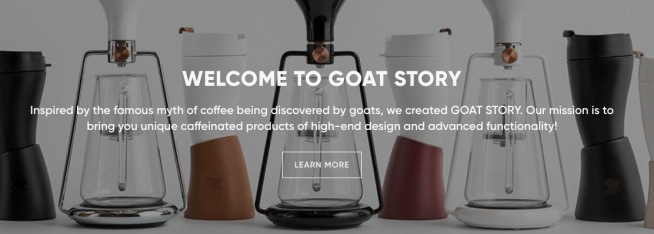
Their homepage not only encapsulates perfectly the need for their target audience to experience coffee in a more artsy and innovative fashion—a fashion with a distinctive style—but also they mention a fact not many people know about the humble beginnings of coffee stemming from a goat, which has inspired their product. The interest in information also drives the target audience and thus drives the marketing successfully.
These interpretations of important. But these interpretations being just that—interpretations—it should be kept in mind the overlapping nature of these trait structures.
Read this from McCrae’s article: “McCrae and Costa (1990) argued…that each of the five factors can be regarded both as a set of traits that must be structured and organized, and as a contributor to the organization and interaction of other traits. Consider O and C: Open people are inquisitive. If they are also conscientious, their curiosity may take the form of sustained and systematic study of a topic; if they are low in C, theirs will be an idle curiosity, absorbed by the passing interest of the moment. Theoretical elaboration of such interactions of factors can bring a more dynamic flavor to trait psychology.”
The organization of a customer’s actions could be directed by two or more separate traits, one or more directing the flow of action that could lead to a destination determined by another.
In an article by Trapnell (HERE), he discusses the difference in interpretation over the behavior of self-reflection, which for a good period of time was presumed to be indicative of the Neuroticism trait.
Trapnell, however, proved that there were different motivations behind a given person’s desire to self-reflect. He divided the need to self-reflect into two separate types: reflection and rumination. Rumination was what was most familiar historically. It described someone who was preoccupied with how they looked, how they acted or thought, someone always conscious of their flaws; so preoccupied that they couldn’t act. Those who are ruminative are self-conscious.
Those, however, who are reflective are self-examining; that is, they are interested, out of a generalized curiosity, in their state of mind, in how their perceived by others, how they process through a given problem. These people are not neurotic, they fall under the category Openness to Experience.
Trapnell showed that a perceived behavior can have two different motivations, can have two different trait categories from which they originate.
So I’ll leave you with this last bit of advice—to always examine all facets of a potential customer’s actions before you put the pen to paper. My last post detailed my process in the context of MedReps. I said customers were most likely those from the STEM program and were thus goal-oriented and Conscientious. What I should have kept in mind, too, was that MedReps catered to salesmen, who fall under the Extraversion category. While writing the copy for that homepage I could’ve kept that in mind and further hit upon the need to be active, to be at the forefront of knowledge, etc.
Next week I’m going to discuss how to further distinguish which trait your potential customer might fall into. I hope you enjoyed this. See you next week.
Enjoy yourself and life.
Best,
Cameron Edward Reilly (ER Copy)
Twitter: https://twitter.com/ercopywriting
Email: cameronedwardreilly@gmail.com
Instagram: https://www.instagram.com/ercopywriting/


6 thoughts on “The Five Factor Model — February 4, 2018”